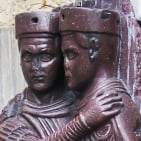Howdy, Stranger!
Categories
- All Categories
- 39 Introductions
- 3.6K Typeface Design
- 764 Font Technology
- 1K Technique and Theory
- 587 Type Business
- 435 Type Design Critiques
- 526 Type Design Software
- 30 Punchcutting
- 132 Lettering and Calligraphy
- 79 Technique and Theory
- 53 Lettering Critiques
- 461 Typography
- 289 History of Typography
- 111 Education
- 61 Resources
- 479 Announcements
- 74 Events
- 104 Job Postings
- 147 Type Releases
- 153 Miscellaneous News
- 259 About TypeDrawers
- 52 TypeDrawers Announcements
- 109 Suggestions and Bug Reports
Options
Lining tnum in italic shape
 mauro sacchetto
Posts: 353
mauro sacchetto
Posts: 353
Generally, in roman shape tabular digits (lining tnum) are realized centering the glyphs into a fixed lenght, the same one for all. This way, left and right bearing are symmetric for each glyph.
But: for italic shape? Which is the requested technic? In the most part of fonts, I see the same total space,but an asymmetric bearing...
Thank you!
Tagged:
0
Comments
Generally, if you are using tabular numbers, they do not fit into text. In this case, proportional numbers, lining or old style, are better used.
Moreover, I do not understand the logic of creating certainly irregular tabular figures due to a totally uncertain proximity to a Roman text ...
No matter which advanced width figures take the goal is to make them "look" centered on that width, which usually means different SB values.
Or you would like to say that tabular figures in italic don't even look centered?
So the spacing and offset of tabular italic numeral glyphs needs to coordinate with the spacing and offset of all the other italic glyphs, and you also want words or numbers in italics to be spaced correctly between non-italic words (which will, in turn, mean that vertical columns of italic and non-italic numbers will align nicely).
To achieve this, the best method is to define a fixed measurement height for sidebearings, somewhere around the middle of the x-height, and use that across the entire family of all styles and weights.